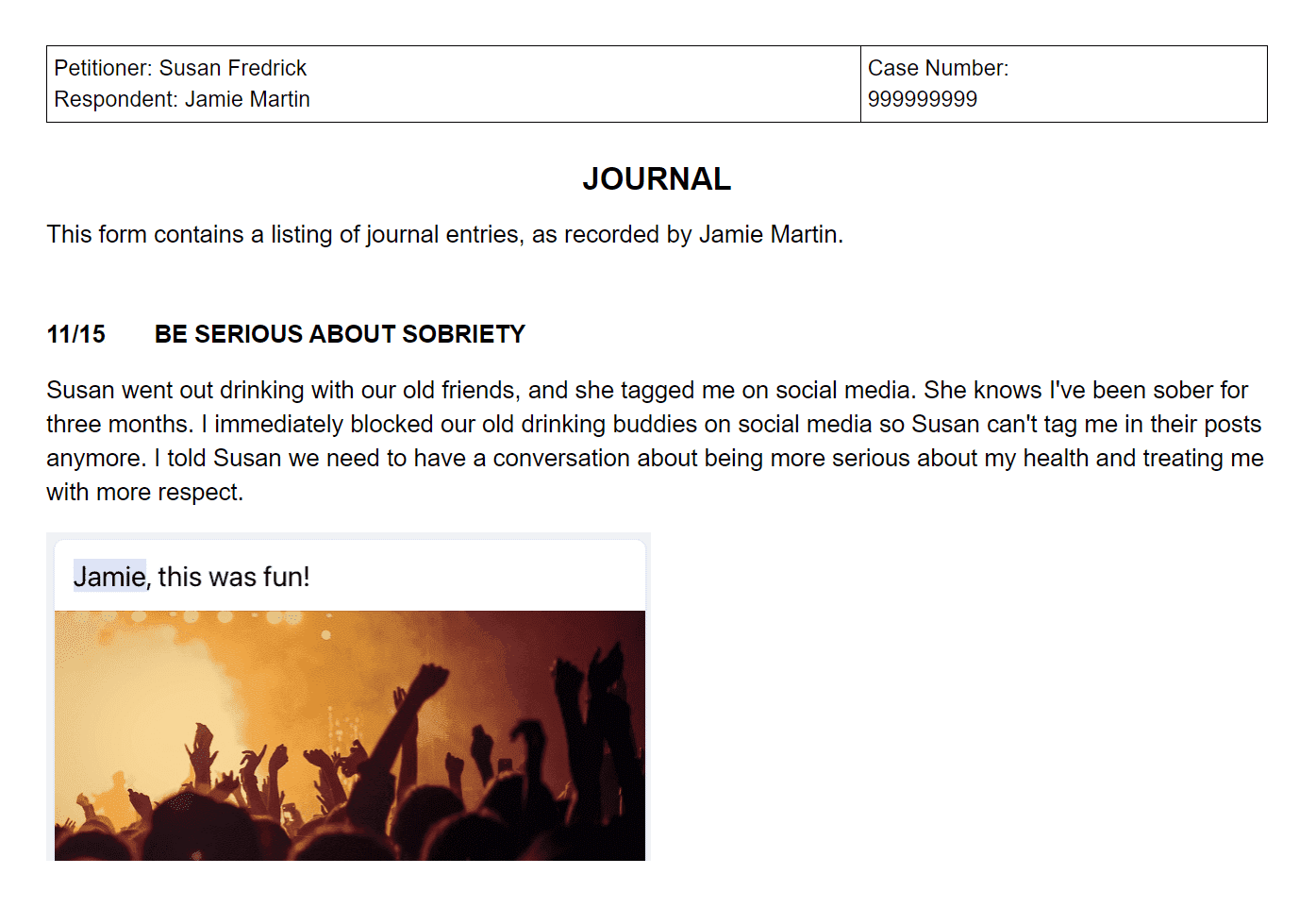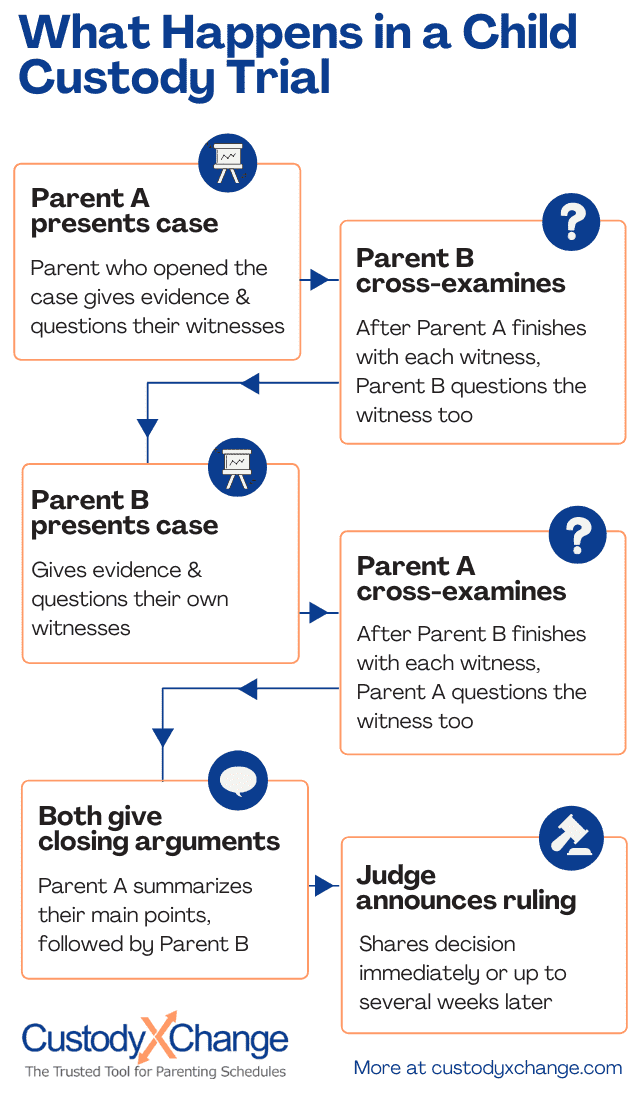Best Evidence for Child Custody Cases
Evidence is the most important part of your custody case. It supports what you believe is best for your child. The evidence you present in court determines whether the judge rules in your favor.
You should start collecting evidence immediately — even before you start a case. A lawyer is best equipped to inform you of the best evidence for child custody, but the following will put you on the right path to building a solid case.
What is admissible evidence in family court?
Admissible evidence is evidence you are allowed to present in court. Admissible evidence largely depends on the rules of evidence of your court and the individual details of your case. You'll have to do some research to determine what you're allowed to present.
Inadmissible evidence is evidence you cannot present in family court. For example, hearsay — repeating something you claim another person said — is generally inadmissible. Evidence that is not directly related to an issue in dispute is often inadmissible as well.
If there's disagreement over whether your evidence is valid, you may have an evidentiary hearing at which the judge examines it. (This type of hearing is common in Minnesota family cases, for example.) The judge may be able to decide the whole case right there at the evidentiary hearing, making it the final hearing (the custody trial).
The types of evidence discussed here are admissible in most courts.
Best types of evidence for custody cases
Your evidence should demonstrate that the custody and parenting time arrangement you're requesting would be in your child's best interests.
For each point you'll argue, consider which evidence would prove it. For example, to demonstrate that you've been an involved, supportive parent, you may want to show a school record of a parent–teacher conference. To highlight a communication failure with the other parent, you may point to your emails in which you discussed who was supposed to take your child for the long weekend.
The following types of evidence can support your case.
Official documents
Gather official documents to show your parental fitness:
- Income information like tax returns and pay stubs to show you are financially stable
- Medical records to show your child receives proper medical care
- School reports to show your child's grades, which are often a reflection of their home life
- Police reports of any incidents involving the other parent
Personal records
Personal records are created by you. They can show your present relationships with the child and the other parent and how you contribute to your child's upbringing.
Records that can help your case include:
- A proposed visitation schedule showing when you'd like to exchange the child
- If you already have a schedule, a list of missed or denied parenting time
- An expense report showing you contribute financially to your child's needs
- Printouts of texts, emails and other messages with your co-parent
- Log of phone calls to show you make an effort to speak with your child
Photos and videos
The court will want to know whether you have an established relationship with your child. Photos and videos can help show this.
A few examples of what visuals can prove:
- You have a stable home for the child.
- You spend time with the child (e.g., taking them on vacation).
- You attend the child's extracurricular events.
- You make an effort to keep the other parent involved in the child's life.
Social media posts
Parents may unwittingly post information that could impair their case on social media.
Social media posts can show:
- The parent's behavior (e.g., frequent partying)
- The parent-child relationship
- The relationship between parents
- Income (e.g., posts about big purchases)
If you plan on using social media posts as evidence, you'll need to prove they are authentic and unedited. Make sure the person's profile name is visible in any screenshots you take, along with the date.
 You can customize this with Custody X Change.
You can customize this with Custody X Change.
Journals
A custody journal can help illustrate your relationships with the child and the other parent.
In your journal, you can document:
- Situations in which you don't believe the other parent acted in the child's best interests
- Interactions with the other parent
- Quality time you spend with the child
- The child's emotional state
- The child's medical appointments
- The child's behavior
Even if you don't use the journal as evidence, a journal can help you figure out whom to call as a witness and recall events when you go to court.
Witness testimony
Witnesses provide context for your allegations. Make a list of reliable witnesses with their names and contact information.
Witnesses can weigh in the following ways:
- Written testimony: A person writes their firsthand account of an incident relevant to the case.
- Out-of-court depositions: A witness answers questions under oath outside of court.
- Live witness testimony: You or your lawyer questions your witnesses and the other side's witnesses during trial.
- Private testimony from the child: A judge interviews the child to understand their feelings.
- Character reference letters: Teachers, coaches and others weigh in on your relationship with your child.
- Custody evaluations: An expert writes a report based on their investigation of the family.
Future plans for the child
The judge will want to see that you've thought about your child's future. To prove this, you can:
- Prepare a parenting plan and visitation schedule.
- Explain how you will keep the other parent involved in your child's life.
- Show that you have childcare arrangements for your child or that you can adjust your work schedule to accommodate your child.
How to organize evidence for a custody case
Once you have the best evidence for your child custody case, you'll need to organize it.
Consider preparing a custody documentation binder to organize your paperwork. A trial binder holds important documents, notes and other evidence you plan to present in court.
If the formatting is up to you, choose a standard font and a readable font size.
Make three copies of each document (one for the judge, one for the witness and one for the other party). Put each document in a clear plastic sleeve to protect it. Use section dividers to organize your paperwork by the following.
- Court documents (everything you've filed for the case)
- Opening statements (draft of a summary of the evidence you'll present in court)
- Evidence (documents, photos, etc.)
- Information about witnesses (summary of all witnesses, questions you'll ask them, documents related to their testimony that you will give them)
- Closing statements (draft of a summary of the case you presented)
If any of your evidence is in a language other than English, you may need to hire a certified translator to provide a translation that the court will accept.
Prepare your witnesses for how they'll testify. Apart from their obligation to tell the truth, you're allowed to work with them to present your narrative.
How to submit evidence in family court
Before trial, the other parent (and their lawyer, if any) is entitled to see your evidence. Sharing evidence enables each side to anticipate the other's arguments and prepare their own.
A document or other item used in court as evidence is called an exhibit. "To exhibit" means to show off or display something, so think of this as what you'll show the court.
The other type of evidence is witness testimony. Witnesses may be friends and family, or they may include experts like custody evaluators. Their testimony can be spoken or written.
If you have a lawyer who will represent you at trial, they'll take care of the evidence submission for you. If the other parent has a lawyer too, the lawyers may have a way to share the evidence in their e-filing system.
If you're representing yourself and you've filed your case on paper, keep some kind of proof (e.g., an email or a post office receipt) that you've delivered the evidence to the other parent.
Especially if you're representing yourself:
Consult the rules of evidence in your area. For example, in the United States, look at the statewide level, e.g., the California Evidence Code, the Texas Rules of Evidence, Guide to New York Evidence, the Florida Evidence Code or the Illinois Rules of Evidence. You should also check if your local court has its own rules.
Give the court a list of exhibits as well as a list of witnesses you'll call. These are usually due about a week before trial; each local court sets its own deadlines.
Give the documents themselves to the other parent. For example, if you tell the court that your evidence will include "David's report card, the daycare's pickup log for baby Nora, and the medical records of both children," you have to get those records from the school, daycare and pediatrician and provide them to the other parent before trial.
How to present evidence in family court
By the day of your trial, your exhibits should be well organized, and your witnesses should be prepared and ready to go.
Have your printed exhibits with you, ready to read aloud or hand to the judge so they can read it for themselves.
If you need to play audio or video, find out what formats you need to provide, like a CD or flash drive. The court may have its own media devices for playing audio and video evidence on a large screen at high volume. You can't play any evidence on your phone (and probably can't bring your phone into the courtroom at all).
As you introduce each piece of evidence, you'll briefly describe it. For example, for an email you'll say who wrote it and to whom it was sent; for a photo you'll say who took it and who appears in it; for a piece of clothing, you'll say to whom it belongs and whether it's in the same condition you remember it. You tell the court that you're providing accurate information, and you ask the judge to accept it as evidence.
Texas allows jury trials. If you're having one, learn your local court's rules for how to show the evidence to the jury.
One parent presents their side, citing their evidence. Their lawyer (if they have one) asks questions to help them tell their story and to highlight the facts. The other side then cross-examines them to poke holes in their argument.
Then it's the other parent's turn to present their side and be questioned and cross-examined.
Speak slowly and clearly. Don't treat this as a dramatic performance. You aren't being judged on how much emotion you show. In fact, it's better to stay calm, as it presents you as a stable, reassuring presence in your child's life. Respond to questions directly and briefly. Always tell the truth.

The tools you need for custody court
The Custody X Change app has many tools to help with your child custody case.
- Create a detailed parenting plan that shows your requested custody arrangements and co-parenting rules in airtight legal language, demonstrating your competency.
- Make a custom parenting time schedule to show the judge the physical custody arrangement you want.
- Keep a custody journal to keep a record of co-parenting issues and organize evidence.
- Use parent messaging to keep an accurate record of your conversations with the other parent.
- Link your account to your lawyer's so they can help you gather evidence.
